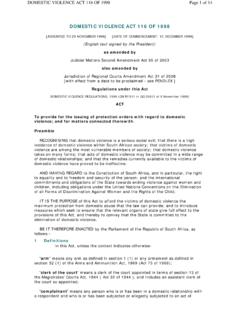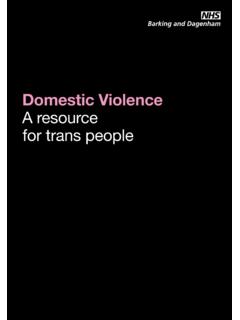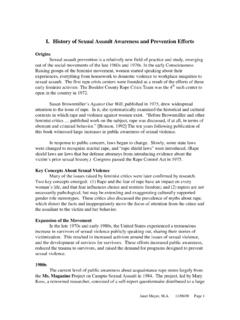Transcription of Domestic violence in South Africa - Family law
1 POLICY BRIEF 71 | november 2014. Domestic violence in South Africa Lisa Vetten Summary Recommendations South Africa 's response to Domestic violence is of relatively recent In order to combat Domestic origin, with 1993 marking both the introduction of the first legal remedy violence in South Africa , this to address Domestic violence , and the recognition of marital rape policy brief recommends that: as a crime. This first attempt to deal with Domestic violence through 1 Further research should be legislation, namely the Prevention of Family violence Act, was further conducted on all forms of Family developed and strengthened through the Domestic violence Act of 1998. violence in South Africa , especially (DVA), which is widely considered one of the more progressive examples the co-occurrence of child abuse of such legislation internationally. This policy brief describes the extent with intimate partner violence . Services may need to be adapted to and nature of Domestic violence in South Africa and considers aspects of ensure they address the presence of the implementation of the DVA, the state's most prominent intervention in both forms of violence in families.
2 The problem of Domestic violence . 2 The police should record the relationship between perpetrator and victim and report on this. South Africa 's Domestic violence Act of 1998 (DVA) casts its net wide to incorporate a range of intimate and Family relationships within its ambit. These include 3 Policies and programmes should be developed to address the economic drivers heterosexual, gay and lesbian relationships; marriage and co-habitation, as well as dating relationships and relationships that have ended; parent-child relationships, as of Domestic violence . well as sibling relationships and those between members of the extended Family . 4 The state funding of services (including the provision of shelter) to the victims of abuse Extent and nature of Domestic violence in South Africa Domestic violence is therefore a broad term that encompasses intimate partner needs to be improved. Micro- violence , child abuse, elder abuse and violence between siblings.
3 Finance, along with the provision In addition to its presence in different types of Family relationships, Domestic violence of long-term housing, could also takes a range of forms. These include: significantly assist abused women. Physical and sexual abuse 5 The feasibility of regulating the availability of alcohol should be examined. Economic abuse, defined as unreasonably depriving Family members of economic and financial resources to which they are legally entitled (including by unreasonably disposing of household effects or other property). policy brief Emotional, verbal and psychological abuse, described by the Act as consisting of a pattern of degrading or humiliating conduct, repeated threats or the repeated exhibition of possessiveness or jealousy which is such as to constitute a serious invasion of the complainant's privacy, liberty, integrity or security Any other controlling behaviour such as intimidation, harassment, stalking, damage to property, and entering the victim's home without permission Measuring the extent of Domestic violence therefore requires paying attention to different sorts of familial and intimate relationships, as well as different types of abuse.
4 Police data does not offer a comprehensive guide to this terrain. Administrative data and Domestic violence There is no crime termed Domestic violence '. Instead, its multiple forms are captured across a range of different categories of criminal offences such as assault (either common or with intent to cause grievous bodily harm), pointing a firearm, intimidation, rape or attempted murder (among other charges). When violated, protection orders issued in terms of the DVA are dealt with as charges of contempt of court. This is because the abuser has ignored an instruction from the court to refrain from assaulting or otherwise harming the complainant. When the South African Police Service (SAPS). reports on crime statistics each year, it does not say how many of these crimes were perpetrated in the context of Domestic violence . Very little can therefore be gleaned from the SAPS' 2012/13 analysis of the crime statistics, which only show common assault to have declined from 280 942 reports in 2003/04 to 172 909 in 2012/13, while assault with intent to cause grievous bodily harm has decreased over the same time period from 260 082 to 185 893 Women have constituted the great majority of protection order applicants since the DVA came into operation in 1999.
5 When analysing police statistics, researchers have found intimate partner violence to be significantly under-reported. Between April 2008 and March 2009, 12 093 women In in Gauteng, or 0,3% of the adult female population, reported an assault by an 1999. intimate partner to the police. In contrast, during the same time period 18,1% of women in the province reported an experience of violence at the hands of intimate male partners to A case study conducted in one locality in Mpumalanga offers another illustration of South Africa 's female how police statistics underestimate the incidence of intimate partner violence in any homicide rate was one area. From 1 January 2006 to 31 July 2007, 942 reports of some form of intimate 6. partner violence were made to one local police station and hospital, as well as to the TIMES courts serving the area, with the greatest proportion of these reports (44,6%) identified from police records. However, only 6,7% of these reports made their way into official statistics, as only 63 women pressed the global average, with half of these This case study also points to how abused women seek assistance from a variety deaths caused by intimate of institutions, all of whose records potentially provide additional insight into different male partners aspects of Domestic violence .
6 For example, figures supplied by the Department of Justice and Constitutional Development show that over 200 000 people annually 2 Domestic violence IN South Africa . turned to the courts for protection orders between 2009 and While these studies offer some insight into the nature of 2011 (although not all were granted the relief they sought).4 Domestic violence , neither they nor police data offers accurate Utilising the census figures for 2012 (calculating the South indicators of the prevalence of Domestic violence . These African population at 52 274 945 people) it can be estimated estimates are better derived from community-based surveys of that 417 people in every 100 000 applied for protection orders representative samples of women and men. A few such studies in 2011. have been conducted in South Africa , chiefly of intimate partner Table 1: Number of protection orders granted violence , and their findings are summarised next.
7 From 2009 2011 Intimate partner violence Year Number of new applications for protection orders Intimate partner violence is the most common form of violence 2009 226 402. experienced by South African women, according to the South African Stress and Health (SASH) survey conducted by Johns 2010 224 486. Hopkins University and the University of Cape Town. Such 2011 217 987. violence was reported by about one in eight women (13,8%). Total 668 875 in the study and by 1,3% of Other local studies asking Source: J Watson, Justice for Domestic violence victims? Key findings of the women only about their experiences of sexual violence and oversight interventions by the PC and SC on women, children and persons intimate partner violence have found a higher proportion of with disabilities with respect to the Department of Justice and Constitutional Development, Parliament of the Republic of South Africa , 2012 women reporting intimate partner violence than that found in the SASH study.
8 Studies reviewing applications for protection orders in terms of In 1998, one in four women (25%) in the provinces of Limpopo, the DVA also provide a glimpse into the troubled nature of Family Mpumalanga and the Eastern Cape reported being physically relationships generally. assaulted by a male partner over the course of their lifetimes, violence in the Family while one in ten (10%) had experienced such violence in the past More recently, research in 2010 found that just Women have constituted the great majority of protection order under one in five women (18,13%) in Gauteng reported an applicants since the DVA came into operation in 1999, with men incident of violence by an intimate Men in some comprising between 14,8% at one court5 and up to 29,5% of localities have also reported perpetrating violence towards their applicants at Reviews of these various applications female partners: 42,3% of a sample of 1 378 men working in showed that while more than two-thirds of the women were Cape Town municipalities admitted to having used physical seeking protection from their intimate male partners, only half violence against a partner in the past 10 years and 8,8% to of the men sought protection from their female partners, with committing such violence in the past the remaining half seeking protection from a Family member (typically their adult children).
9 7 These findings suggest that At its most extreme, Domestic violence will result in death. In while women may be at risk of Domestic violence throughout 1999, South Africa 's female homicide rate was six times the their lifetimes, men's risk is largely confined to childhood and global average, with half of these deaths caused by intimate later adulthood. male partners16 a phenomenon that has come to be termed intimate femicide.' In more everyday terms, this translated Children have featured as both victims and perpetrators in into four women killed every day by the men in their studies examining the implementation of the DVA, with adult children being the group from whom applicants were most likely to seek protection, after intimate Younger children, In more everyday terms, this translated by contrast, were the group most likely to be identified as being abused in addition to the primary applicant for a protection into four women killed every day by This suggests that men's violence towards their female the men in their lives partners often co-occurs with child abuse.
10 Applications for protection orders also illustrated how ending A decade later, when this analysis of female homicides was relationships did not necessarily result in an end to abusive repeated in 2009, a reduction in the overall female homicide rate behaviour. Former partners were cited in 10,8% of applications was found. However, even though the prevalence of intimate at one court10 and in more than a third of applications (36,9%) at femicide decreased from 8,8/100 000 in 1999 to 5,6/100 000. other in 2009, this decline was not large enough to reach statistical POLICY BRIEF 71 NOVEMBER 2014 3. policy brief significance. The drop in the number of non-intimate homicides was, however, large enough to be statistically Since the decrease in the number of intimate femicides was not as great as the decrease in the number of non-intimate homicides, intimate femicide is now the leading cause of female homicides. In 1999 it accounted for 50% of female homicides, and in 2009 it accounted for 57% of female While South Africa 's rate of intimate femicide (female homicide) may have been five times the global average in 2009, the prevalence rate of non-lethal intimate partner violence is somewhat less extreme.






